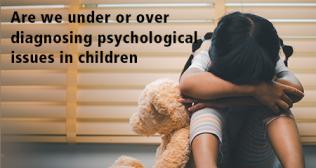}}drupal-data/images/blog-details.png)
Mental Health and Behavioural Sciences
National Bullying Prevention Month
Dr. Samir Parikh Oct 15, 2015
Despite an increasing prevalence of bullying and its significant consequences, there is still an under reporting of such incidents today. This is mainly due to a lack of awareness and information regarding the identification an intervention for bullying. It is important to note that bullying is not restricted simply to the youth occurring solely in schools and colleges, but it also can be witnessed by almost all of us across our lifespan, including at our workplace, in the community, at a public place, amongst peers, or even within our own family. Forms of Bullying
Bullying is most commonly thought of in terms of physical aggression, including hitting, kicking or pushing someone. However, bullying could be manifested in a variety of forms, for instance other physical forms of bullying could include making rude gestures, stealing or hiding or destroying others’ belongings, or even making someone do something he or she doesn’t want to do. In addition, bullying could be verbal, including name calling, teasing, insulting or threatening, interpersonal, including avoiding to talk to someone, spreading rumours, isolating or alienating a person, or embarrassing the person.
Role of bystander
Bullying is a form of aggressive behavior which is intentional and leads to discomfort or harm. The basic premise underlying the dynamics between the bully perpetrator and a victim is the imbalance of real or perceived power. Further, in addition to the perpetrator and the victim, the bystander or witness also plays a significant role in determining the outcome of the bullying incident. A bystander could play different roles, being a passerby, an observer, a participant, a follower, a defender or an outsider. Such a person may choose to actively intervene to stop the bully, or to encourage the bully to continue, or might even choose to view the bullying passively.
Seeking help
It is understandable that a victim of bullying may not always be willing to seek help. This is because of a combination of multiple reasons, including a fear of the consequences from the bully, a feeling of isolation or alienation, a fear of being perceived as weak or a tattletale, etc. Further, some of them might not even know whom to reach out to for help, and may not want others to know for fear of humiliation, fearing being rejected by their peers. And the worst case scenario could be when the person might consider him or herself to be guilty or responsible in some way for the bulling behavior. Therefore, it is important to create awareness amongst people, especially the young children, to know that asking for help is a sign of strength.
Prevention
First and foremost, it is important to understand that bullying is rarely meant to be spiteful in nature, and there are likely to be multiple factors contributing towards the bullying behaviour. Some of these factors could include less parental involvement, low threshold for frustration tolerance, and an exposure to violence, history of having been a victim of bullying, or difficulty in channelizing one’s anger. Thereafter, it becomes pivotal to understand the factors underlying the target of bullying, as it is usually the one who is perceived as different from their peers, as weak, or unable to defend self, who is chosen as an easy target.
While it is necessary to equip all individuals with the necessary assertiveness skills to be able to know what to do in the moment and to learn how to stand up to the bully, it is also important to develop a multicomponent model to prevent such tendencies, especially in schools as it is the young children who are most vulnerable. The bystanders also need to be strengthened, encouraging a shared concern and sense of shared responsibility.
The utmost need for awareness programs to be conducted extensively cannot be emphasized enough, as it is not just the children but the teachers, the parents, and the community at large which needs to be aware of the nature, consequences and skills required to deal effectively with bullying. There is also a strong need to create and implement school wide anti-bullying rules and policies, which helps the children know the consequences of such actions.
At a classroom level, social and interpersonal skills training needs to be encourages, building healthy peer support systems, encouraging children to learn to take perspectives of each other, while at the same time focusing on teaching emotional awareness and regulation, and focusing on prosocial behaviours which inculcate the values of empathy, compassion, care and cooperation.
There is a growing requirement of the creation as well the implementation of bullying prevention and intervention policies which are sensitive to the needs of the individuals in order to ensure their healthy psychological well-being. Due to the increasing prevalence of bullying in schools, it is imperative to ensure an early identification as well as intervention of such incidences in order to prevent the long lasting consequences on the children’s social, academic and psychological functioning. On the occasion of the national bullying prevention month, it becomes important to reiterate the need for implementing adequate strategies to check such behavioural tendencies.
Forms of Bullying
Bullying is most commonly thought of in terms of physical aggression, including hitting, kicking or pushing someone. However, bullying could be manifested in a variety of forms, for instance other physical forms of bullying could include making rude gestures, stealing or hiding or destroying others’ belongings, or even making someone do something he or she doesn’t want to do. In addition, bullying could be verbal, including name calling, teasing, insulting or threatening, interpersonal, including avoiding to talk to someone, spreading rumours, isolating or alienating a person, or embarrassing the person.
Role of bystander
Bullying is a form of aggressive behavior which is intentional and leads to discomfort or harm. The basic premise underlying the dynamics between the bully perpetrator and a victim is the imbalance of real or perceived power. Further, in addition to the perpetrator and the victim, the bystander or witness also plays a significant role in determining the outcome of the bullying incident. A bystander could play different roles, being a passerby, an observer, a participant, a follower, a defender or an outsider. Such a person may choose to actively intervene to stop the bully, or to encourage the bully to continue, or might even choose to view the bullying passively.
Seeking help
It is understandable that a victim of bullying may not always be willing to seek help. This is because of a combination of multiple reasons, including a fear of the consequences from the bully, a feeling of isolation or alienation, a fear of being perceived as weak or a tattletale, etc. Further, some of them might not even know whom to reach out to for help, and may not want others to know for fear of humiliation, fearing being rejected by their peers. And the worst case scenario could be when the person might consider him or herself to be guilty or responsible in some way for the bulling behavior. Therefore, it is important to create awareness amongst people, especially the young children, to know that asking for help is a sign of strength.
Prevention
First and foremost, it is important to understand that bullying is rarely meant to be spiteful in nature, and there are likely to be multiple factors contributing towards the bullying behaviour. Some of these factors could include less parental involvement, low threshold for frustration tolerance, and an exposure to violence, history of having been a victim of bullying, or difficulty in channelizing one’s anger. Thereafter, it becomes pivotal to understand the factors underlying the target of bullying, as it is usually the one who is perceived as different from their peers, as weak, or unable to defend self, who is chosen as an easy target.
While it is necessary to equip all individuals with the necessary assertiveness skills to be able to know what to do in the moment and to learn how to stand up to the bully, it is also important to develop a multicomponent model to prevent such tendencies, especially in schools as it is the young children who are most vulnerable. The bystanders also need to be strengthened, encouraging a shared concern and sense of shared responsibility.
The utmost need for awareness programs to be conducted extensively cannot be emphasized enough, as it is not just the children but the teachers, the parents, and the community at large which needs to be aware of the nature, consequences and skills required to deal effectively with bullying. There is also a strong need to create and implement school wide anti-bullying rules and policies, which helps the children know the consequences of such actions.
At a classroom level, social and interpersonal skills training needs to be encourages, building healthy peer support systems, encouraging children to learn to take perspectives of each other, while at the same time focusing on teaching emotional awareness and regulation, and focusing on prosocial behaviours which inculcate the values of empathy, compassion, care and cooperation.
There is a growing requirement of the creation as well the implementation of bullying prevention and intervention policies which are sensitive to the needs of the individuals in order to ensure their healthy psychological well-being. Due to the increasing prevalence of bullying in schools, it is imperative to ensure an early identification as well as intervention of such incidences in order to prevent the long lasting consequences on the children’s social, academic and psychological functioning. On the occasion of the national bullying prevention month, it becomes important to reiterate the need for implementing adequate strategies to check such behavioural tendencies.
 Forms of Bullying
Bullying is most commonly thought of in terms of physical aggression, including hitting, kicking or pushing someone. However, bullying could be manifested in a variety of forms, for instance other physical forms of bullying could include making rude gestures, stealing or hiding or destroying others’ belongings, or even making someone do something he or she doesn’t want to do. In addition, bullying could be verbal, including name calling, teasing, insulting or threatening, interpersonal, including avoiding to talk to someone, spreading rumours, isolating or alienating a person, or embarrassing the person.
Role of bystander
Bullying is a form of aggressive behavior which is intentional and leads to discomfort or harm. The basic premise underlying the dynamics between the bully perpetrator and a victim is the imbalance of real or perceived power. Further, in addition to the perpetrator and the victim, the bystander or witness also plays a significant role in determining the outcome of the bullying incident. A bystander could play different roles, being a passerby, an observer, a participant, a follower, a defender or an outsider. Such a person may choose to actively intervene to stop the bully, or to encourage the bully to continue, or might even choose to view the bullying passively.
Seeking help
It is understandable that a victim of bullying may not always be willing to seek help. This is because of a combination of multiple reasons, including a fear of the consequences from the bully, a feeling of isolation or alienation, a fear of being perceived as weak or a tattletale, etc. Further, some of them might not even know whom to reach out to for help, and may not want others to know for fear of humiliation, fearing being rejected by their peers. And the worst case scenario could be when the person might consider him or herself to be guilty or responsible in some way for the bulling behavior. Therefore, it is important to create awareness amongst people, especially the young children, to know that asking for help is a sign of strength.
Prevention
First and foremost, it is important to understand that bullying is rarely meant to be spiteful in nature, and there are likely to be multiple factors contributing towards the bullying behaviour. Some of these factors could include less parental involvement, low threshold for frustration tolerance, and an exposure to violence, history of having been a victim of bullying, or difficulty in channelizing one’s anger. Thereafter, it becomes pivotal to understand the factors underlying the target of bullying, as it is usually the one who is perceived as different from their peers, as weak, or unable to defend self, who is chosen as an easy target.
While it is necessary to equip all individuals with the necessary assertiveness skills to be able to know what to do in the moment and to learn how to stand up to the bully, it is also important to develop a multicomponent model to prevent such tendencies, especially in schools as it is the young children who are most vulnerable. The bystanders also need to be strengthened, encouraging a shared concern and sense of shared responsibility.
The utmost need for awareness programs to be conducted extensively cannot be emphasized enough, as it is not just the children but the teachers, the parents, and the community at large which needs to be aware of the nature, consequences and skills required to deal effectively with bullying. There is also a strong need to create and implement school wide anti-bullying rules and policies, which helps the children know the consequences of such actions.
At a classroom level, social and interpersonal skills training needs to be encourages, building healthy peer support systems, encouraging children to learn to take perspectives of each other, while at the same time focusing on teaching emotional awareness and regulation, and focusing on prosocial behaviours which inculcate the values of empathy, compassion, care and cooperation.
There is a growing requirement of the creation as well the implementation of bullying prevention and intervention policies which are sensitive to the needs of the individuals in order to ensure their healthy psychological well-being. Due to the increasing prevalence of bullying in schools, it is imperative to ensure an early identification as well as intervention of such incidences in order to prevent the long lasting consequences on the children’s social, academic and psychological functioning. On the occasion of the national bullying prevention month, it becomes important to reiterate the need for implementing adequate strategies to check such behavioural tendencies.
Forms of Bullying
Bullying is most commonly thought of in terms of physical aggression, including hitting, kicking or pushing someone. However, bullying could be manifested in a variety of forms, for instance other physical forms of bullying could include making rude gestures, stealing or hiding or destroying others’ belongings, or even making someone do something he or she doesn’t want to do. In addition, bullying could be verbal, including name calling, teasing, insulting or threatening, interpersonal, including avoiding to talk to someone, spreading rumours, isolating or alienating a person, or embarrassing the person.
Role of bystander
Bullying is a form of aggressive behavior which is intentional and leads to discomfort or harm. The basic premise underlying the dynamics between the bully perpetrator and a victim is the imbalance of real or perceived power. Further, in addition to the perpetrator and the victim, the bystander or witness also plays a significant role in determining the outcome of the bullying incident. A bystander could play different roles, being a passerby, an observer, a participant, a follower, a defender or an outsider. Such a person may choose to actively intervene to stop the bully, or to encourage the bully to continue, or might even choose to view the bullying passively.
Seeking help
It is understandable that a victim of bullying may not always be willing to seek help. This is because of a combination of multiple reasons, including a fear of the consequences from the bully, a feeling of isolation or alienation, a fear of being perceived as weak or a tattletale, etc. Further, some of them might not even know whom to reach out to for help, and may not want others to know for fear of humiliation, fearing being rejected by their peers. And the worst case scenario could be when the person might consider him or herself to be guilty or responsible in some way for the bulling behavior. Therefore, it is important to create awareness amongst people, especially the young children, to know that asking for help is a sign of strength.
Prevention
First and foremost, it is important to understand that bullying is rarely meant to be spiteful in nature, and there are likely to be multiple factors contributing towards the bullying behaviour. Some of these factors could include less parental involvement, low threshold for frustration tolerance, and an exposure to violence, history of having been a victim of bullying, or difficulty in channelizing one’s anger. Thereafter, it becomes pivotal to understand the factors underlying the target of bullying, as it is usually the one who is perceived as different from their peers, as weak, or unable to defend self, who is chosen as an easy target.
While it is necessary to equip all individuals with the necessary assertiveness skills to be able to know what to do in the moment and to learn how to stand up to the bully, it is also important to develop a multicomponent model to prevent such tendencies, especially in schools as it is the young children who are most vulnerable. The bystanders also need to be strengthened, encouraging a shared concern and sense of shared responsibility.
The utmost need for awareness programs to be conducted extensively cannot be emphasized enough, as it is not just the children but the teachers, the parents, and the community at large which needs to be aware of the nature, consequences and skills required to deal effectively with bullying. There is also a strong need to create and implement school wide anti-bullying rules and policies, which helps the children know the consequences of such actions.
At a classroom level, social and interpersonal skills training needs to be encourages, building healthy peer support systems, encouraging children to learn to take perspectives of each other, while at the same time focusing on teaching emotional awareness and regulation, and focusing on prosocial behaviours which inculcate the values of empathy, compassion, care and cooperation.
There is a growing requirement of the creation as well the implementation of bullying prevention and intervention policies which are sensitive to the needs of the individuals in order to ensure their healthy psychological well-being. Due to the increasing prevalence of bullying in schools, it is imperative to ensure an early identification as well as intervention of such incidences in order to prevent the long lasting consequences on the children’s social, academic and psychological functioning. On the occasion of the national bullying prevention month, it becomes important to reiterate the need for implementing adequate strategies to check such behavioural tendencies.
Categories
Clear allMeet the doctor

Dr. Samir Parikh
CONSULTANT MENTAL HEALTH & BEHAVIOURAL SCIENCES | Fortis Shalimar Bagh
- Mental Health and Behavioural Sciences | Mental Health and Behavioural Sciences | Psychiatry | Clinical Psychology
-
21 Years
-
900



















